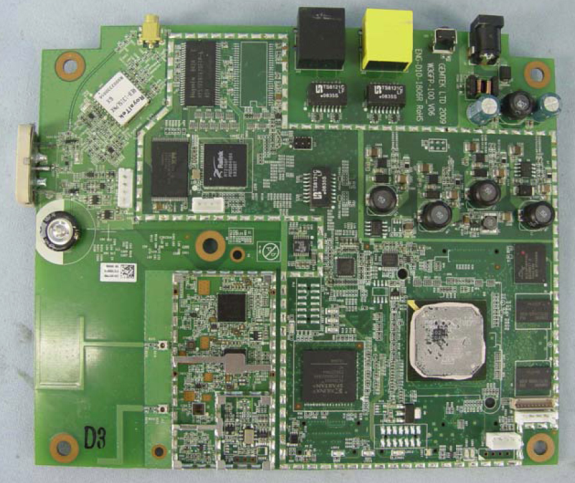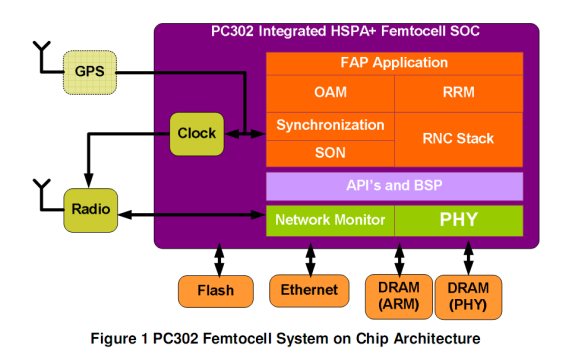AT&T 3G MicroCell: A Comprehensive Exploration
by Brian Klug on April 1, 2010 1:55 AM EST- Posted in
- Smartphones
- AT&T
- Microcell Review
- Mobile
Inside that white shell
So we now know there's relatively little to be learned about the device on the software side. What about the hardware itself? Again, our semiconductor-possessed sensibilities wouldn't be happy unless we got to see what's at this thing's core. I was eager to tear open the box and void some warranties like nobody's business, until I discovered something while doing my homework online that made me stop. Several users on the AT&T Forums reported that they were called by tech support because their MicroCell's tamper switch had been triggered. You read that right, the MicroCell has a built in physical tamper switch. They're that serious about you not getting into this thing. Rather than render the box useless before I even got to use it, I decided on another route.
Instead, I got the FCC ID off the bottom of the box (it's MXF-3GFP980217) and found the FCC filing online. Luckily, the internal photos of the device are freely available and of marginally passable quality. The most important photo is this one, of the board's topside with the heatsink removed:
That's some horrendous barrel distortion, FCC cameraman
I've tried locating the physical tamper switch and can't quite find it, though I'm certain it's there somewhere. Starting from the left, we can see the GPS chipset (RoyalTek) and the external connector just above it. There's also a trace to the Cirocomm internal GPS antenna which is the white square protruding from the board at far left. Running along the top of the board are the two ethernet connectors, reset pin, and DC power in. On the left we can also see two relatively thick traces for the antenna, likely Rx and Tx for the air interface. Interestingly, there are some connector headers also visible at the base of where those traces emerge from the amplifiers. Just south of the GPS RoyalTek chip is a flash TSOP, a Ralink RT2150F chip, and some DRAM up top. Searching for that particular Ralink chip revealed nothing. Given that Ralink traditionally makes wireless access point SoCs and wireless adapters, it's possible this is the device's radio. It's also possible that this is handling routing and ethernet for that "priority mode" configuration mentioned earlier.
Moving right, there's something we don't see every day - except in the domain of high speed signal processing - a Xilinx Spartan 3A FPGA sitting right alongside the platform's SoC. If you squint, you can make out picoChip under that thermal paste, along with 302. It's highly likely this board is using the picoChip PC302 SoC. Remember that 4 simultaneous phone limitation earlier? The PC302 is the only 3GPP Release 7 WCDMA (HSPA) SoC baseband picoChip makes with that implicit restriction, so it's very likely this is what we're seeing here. There's some RAM alongside at right, but it's impossibly hard to make out the markings.
The PC302 is the core of the MicroCell, incorporating a 400 MHz ARM11 processor as well as hardware accelerator support for IPsec, ethernet, and everything you need for a femtocell. Unsurprisingly, picoChip calls this a WCDMA Femto Access Point (FAP) supporting up to 4 users, and 21 Mbps HSDPA, 5.7 Mbps HSUPA. Keep in mind here that although the controller supports a physical layer data rate at those speeds, the air interface, protocol, and implementation limit the speeds further. We'll see that in practice, speeds are lower.












63 Comments
View All Comments
Some1ne - Thursday, April 1, 2010 - link
So let me get this straight. I'm supposed to pay AT&T for access to a device that uses my own Internet connection to patch up holes in their network? That's just ridiculous. It's AT&T's inadequate network coverage that makes these devices necessary in the first place, and now they're actually trying to profit off of having poor network coverage. Pretty much removes any incentive for them to improve their network, now doesn't it?These devices should be provided free of charge, as a "sorry you can't actually use the network that you paid to access" kind of token. Anyone who pays for one of these is just giving AT&T one more reason not to fix their coverage issues.
Alexstarfire - Thursday, April 1, 2010 - link
I rather agree. Makes you wonder what they actually do with all the money they receive monthly. Also means that if you purchase one, much like how it should be if you use an unlocked phone, that your monthly bill should drop in price. Except in this case if they are using your broadband connection then it should practically be free since it provides next to no burden on them, though I don't know what happens after it goes through the connection.therealnickdanger - Thursday, April 1, 2010 - link
How do you know that the actual cost of the device and the technology driving it isn't already subsidized by your bill? Perhaps you're only paying 10% of what it really costs.vol7ron - Thursday, April 1, 2010 - link
Even if a subsidy were included, which would only cover some (not all) of the costs, the fact that people have to pay anything more for it is ridiculous given the nature of what a cell company is: a service. Cell phone companies are in business for one reason and by making you pay anything more to receive the core product is truely sad.There are other companies, like Cisco, that have built their own repeaters and Mobile-to-VOIP products, which I commend, because they are a technology company not providing the service. They're taking something bad, that they don't have control of, and making it bearable. Cell phone providers are at the other end, they have full control but are making you pay more, even though you aren't getting the initial benefit of what you're paying for in the first place.
zinfamous - Thursday, April 1, 2010 - link
This is kind of where I sit with the argument. a one-time ~$150 cost to the customer *may* be cheaper in the end, than having a network-wide upgrade that increases costs across all customers, paying more and more per month.Perhaps it also improves access to those willing, and needing increased network performance, paying a bit more for the premium, while those customers with little need for the bandwidth go on about their normal use, paying what they always have. It's like...a single-payer network structure! :D
DoeBoy - Thursday, April 1, 2010 - link
IT seems to me some people forget that companies are in business to make money. This is a great way for ATT to make a lot of extra money. I live in a rural area and i complain all the time in an area they say has coverage that does not at all. While this would aid me in getting better service it also would require me to pay for an inet connection which is not covered by att. Clearly they aren't a moral company when your service is so bad you have to have a product that uses some other technology(a la internet) and then charge the person not only for that product that gets you service but not even lower your bill since you technically arent using their towers really at all under this sucker. Clearly Verizon and ATT are both big 500lb gorillas. In europe its much easier to get a cheap cell phone deal and coverage. Clark Howard seems to think ATT and Verizon are going to end up being more corporate and smaller companies like t-mobile, cricket, metropcs and what not will fill in the void for the regular consumer.Some1ne - Thursday, April 1, 2010 - link
The problem is that when you look at the pricing matrix, not only is there a fixed upfront cost, there are also recurring monthly fees. It doesn't matter how much the up front cost is subsidized. The monthly fees mean that sooner or later, AT&T will be turning a profit on these devices.And even worse, the fees are higher if you're not already using AT&T as your ISP and/or land-line provider. That makes the least sense out of anything, since if you have a different ISP, then by running the femtocell you are completely unburdening AT&T's network, and dumping all the work onto someone else. The get to sell your bandwidth to someone else, and charge you more while doing it.
taltamir - Thursday, April 1, 2010 - link
in computers, the technology is made mostly of sand... it costs practically nothing.It is the technology you are paying for...
However there is one major component here, AT&T themselves look at it as a "cost cutting method"... in other words it is intended to cost them LESS, aka, they are making MORE of a profit on you if you get one of those then without.
The whole thing is absurd. You pay hundreds of dollars for a black box device with tamper protection and absolutely horrid performance (compared to wifi), then you pay a monthly fee for the privilege of using said device...
they should just put wifi in every device and have wifi be free (but they usually charge a monthly fee for that privilege as well)
ant1pathy - Friday, April 2, 2010 - link
You are, of course, welcome to change carriers. If you feel the service you are recieving is subpar and another carrier would be better for you, the termination fee is probably less than the cost of the box. If you're continuing to pay for a service that does not meet your needs and you can't really use, then you are the pefect consumer.Wolfpup - Wednesday, April 21, 2010 - link
I completely agree. It's absolutely nuts IMO.